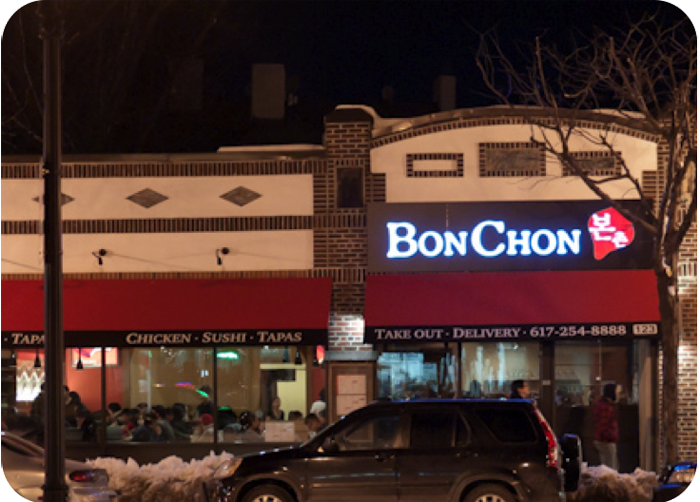 GoogleMaps image of my site.
GoogleMaps image of my site.
The site that I plan on focusing on this semester is the Allston/ Brighton area. As of now, the boundaries I have set is the area enclosed by Harvard Ave, Brighton Ave, Commonwealth Ave, and Linden St. Within these boundaries, I want to study the demographics and history of land usage of the area; more specifically, the history of the Asian culture in Allston. I chose these boundaries because it is a densely populated area, with many shops that allow for research in my areas of interest in the Korean culture.
Korean fried chicken from a restaurant in Allston.
I have visited the Allston/ Brighton area many times after recurring recommendations for “good Korean food”. I have always known it as an unofficial Korea town as the restaurants that flood the streets near Packard’s Corner have always had Korean writing on them. However, a quick google search revealed to me that there is a lot of history in the Allston/ Brighton area, and it hasn’t always prevailed as a Korean-cultured area. I’m very interested in learning about its historical culture and how it progressed to what the area is predominantly known for today.
Looking at the area within Linden and Harvard, I notice that the land use of my site is mostly commercial with a few residential units. The buildings seem older and are mostly one or two stories tall. Though the buildings are old, the insides seem to be renovated to keep up with the modernity of present times. There are smaller restaurants lined up one after the other, and it makes for a fascinating walk. After looking at the history of the architecture of the area, the buildings date back to being built in 1910 to the 1980s (BAHS Neighborhoods). Historically a very commercial site since the early 1900s, the shops switched from beauty salons, dental offices, and professional offices to more restaurants, cafes, and smaller second-hand stores (BAHS).
As previously mentioned, I first discovered this site for its strong reputation for having a variety of Korean restaurants. I explored the area myself and found many Korean barbeque restaurants (BonChon, Korean Garden), Chinese cafes (Jojo Taipei), bubble tea shops (Infusions Tea Spa), vintage clothing/ furniture shops (Urban Renewals), and many other small Asian stores (Between Hours, Fun Snack). Being in Cambridge and Boston, I rarely see prevalent Asian culture (unless in Chinatown), and so I was very intrigued by this site. I want to focus primarily on when the growth of Korean culture started and what it was previously known for before then.
 . Mus suspendisse adipiscing et lacus.
. Mus suspendisse adipiscing et lacus.
I believe it is also important to find the difference in land usage, such as if it has always been residential and commercial in the food industry, or if it had been dominated by a different industry in the past. As mentioned previously, the area is highly commercial, and focuses on the food industry. More research has told me that the section of Allston that I will be studying had been known in the past as an upscale residential area. It is also very close to the “Automile”, which was known for its condensed presence of car dealerships (BAHS). I want to discover when and why the residential to commercial switch happened, and whether it was a mass or gradual one.
 . The "Automile" on Commonwealth Ave.
. The "Automile" on Commonwealth Ave.
 . Allston in the early 1900s
. Allston in the early 1900s
I’d also like to note changes and continuities of the demographics of the area, looking at breakdowns of age and race. I researched more about the demographics of the area and it seems like it has always been home to many immigrant populations, and the majority of its population is single, with an average age of 29 (US Census 2010). Looking at the history of the strip on Harvard Avenue, it is noticed that it was once an upscale residential area with many Jews, Irish, and Italians (BAHS Neighborhoods). However, starting from the early 1900s, the area started to become commercialized and geared towards college students and immigrant groups. Thus, the area became superseded by Southeast Asians, Brazilians, Hispanics, and Russians (BAHS). I want to dive more into why this is, and how the area caters to these groups of people.
Other aspects of culture that I’d also like to study are the music and art scenes in Allston. There aren’t that many music stores lining the area that I am studying, and I’d like to understand where the music scene stems from. Research has shown me that both music and the arts have been appreciated in Allston, and Allston is home to many notable people such as filmmakers, actresses, and rock bands. I’m still uncertain though, of whether or not my specific site has contributed to the prevalence of music and art, but I do plan on investigating further.
Overall, I want to put an emphasis on the changes and continuities of the culture of Allston by studying the demographics, music/ art involvement, and industry development of the area.